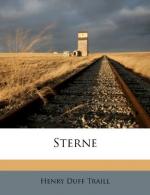According, however, to one strange story the dramatic element gives place after Sterne’s very burial to melodrama of the darkest kind. The funeral, which pointed, after all, a far sadder moral than the death, took place on Tuesday, March 22, attended by only two mourners, one of whom is said to have been his publisher Becket, and the other probably Mr. James; and, thus duly neglected by the whole crowd of boon companions, the remains of Yorick were consigned to the “new burying-ground near Tyburn” of the parish of St. George’s, Hanover Square. In that now squalid and long-decayed grave-yard, within sight of the Marble Arch and over against the broad expanse of Hyde Park, is still to be found a tombstone inscribed with some inferior lines to the memory of the departed humourist, and with a statement, inaccurate by eight months, of the date of his death, and a year out as to his age. Dying, as has been seen, on the 18th of March, 1768, at the age of fifty-four, he is declared on this slab to have died on the 13th of November, aged fifty-three years. There is more excuse, however, for this want of veracity than sepulchral inscriptions can usually plead. The stone was erected by the pious hands of “two brother Masons,” many years, it is said, after the event which it purports to record; and from the wording of the epitaph which commences, “Near this place lyes the body,” &c., it obviously does not profess to indicate—what, doubtless, there was no longer any means of tracing—the exact spot in which Sterne’s remains were laid. But, wherever the grave really was, the body interred in it, according to the strange story to which I have referred, is no longer there. That story goes: that two days after the burial, on the night of the 24th of March, the corpse was stolen by body-snatchers,




